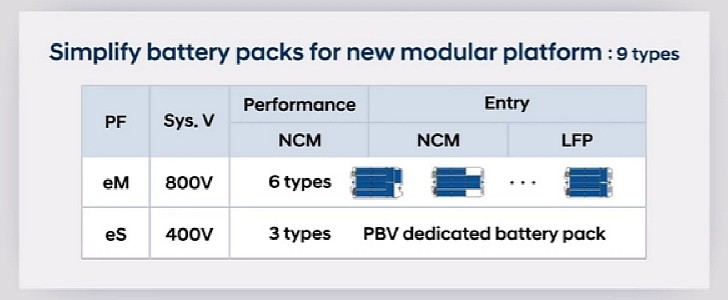Hyundai is enjoying a lot of good feedback with the Ioniq 5. If you count Kia as part of Hyundai (which it is), the Kia EV6 must also make the company proud. Both sit on the E-GMP, a dedicated EV architecture that gave Hyundai quite a competitive edge. According to Jaehoon Chang, that’s just the beginning. Hyundai will have 17 EVs over IMA.
If that sounds a bit cryptic, let’s break that up for you. The Hyundai Motor CEO said at the 2022 CEO Investor Day event that his company is working on a new platform that will be called Integrated Modular Architecture, or IMA for short. Based on the E-GMP, it will allow Hyundai to present 11 new EVs and Genesis to sell another 6, leading their total offerings to 17 electric cars.
Hyundai will sell three sedans, six SUVs, one light commercial vehicle, and one “new type model.” The company said the IONIQ 6 will be sold in 2022 and that the IONIQ 7 will arrive in 2024. Considering the IMA will be introduced in 2025, these IONIQ vehicles will still use the E-GMP.
Genesis will have two passenger cars and four SUVs, one of them being the all-electric GV70, expected for 2022. From 2025 on, the luxury brand will only sell electric vehicles. Kia was obviously not included in the Hyundai Motor plans. Anyway, expected it to be around 10 new electric cars as well: most Hyundai models have a Kia equivalent.
With these cars alone, Hyundai expects to sell about 1.87 million EVs per year by 2030, which would give it a global EV market share of 7%. That means that Hyundai estimates the world will buy 26.71 million electric cars annually by the end of the decade. We wonder who will sell the other 24,84 million EVs.
The IMA is crucial to understanding how Hyundai plans to get there. According to the Korean carmaker, it will use CTP (cell-to-pack), which suggests it will use prismatic cells and LFP (lithium iron phosphate) batteries. Volkswagen already announced that its unified cell will be prismatic and will have at least three different chemistries: LFP, high manganese, and high nickel. Solid-state cells are expected to join.
According to Hyundai, the IMA will fit electric vehicles in all segments thanks to standardized chassis, battery packs, and motors (five types). It will have two derivates: eM, for passenger cars, and eS, for purpose-built vehicles. The eM will allow it to produce an A-segment EV with a single motor and a small battery pack up to a sporty one with at least two motors (some companies use four of them) and a large battery pack focused on a long range. Only the eM derivative will work at 800V: eS vehicles will work at 400V.
Hyundai also has an eye on “next-generation lithium batteries,” such as solid-state cells. The Korean automaker expects to obtain them thanks to strategic alliances. Curiously, the company stated that it expects half of these cells to come from these alliances. If that is the case, Hyundai may be wondering about producing them on its own as well.
Software is also something in which Hyundai plans to invest. OTA (over-the-air) updates should arrive to its vehicles, starting with one by the end of 2022 with the Genesis GV60 and will spread to all the Korean automaker's cars by 2025.
Hyundai will sell three sedans, six SUVs, one light commercial vehicle, and one “new type model.” The company said the IONIQ 6 will be sold in 2022 and that the IONIQ 7 will arrive in 2024. Considering the IMA will be introduced in 2025, these IONIQ vehicles will still use the E-GMP.
Genesis will have two passenger cars and four SUVs, one of them being the all-electric GV70, expected for 2022. From 2025 on, the luxury brand will only sell electric vehicles. Kia was obviously not included in the Hyundai Motor plans. Anyway, expected it to be around 10 new electric cars as well: most Hyundai models have a Kia equivalent.
With these cars alone, Hyundai expects to sell about 1.87 million EVs per year by 2030, which would give it a global EV market share of 7%. That means that Hyundai estimates the world will buy 26.71 million electric cars annually by the end of the decade. We wonder who will sell the other 24,84 million EVs.
The IMA is crucial to understanding how Hyundai plans to get there. According to the Korean carmaker, it will use CTP (cell-to-pack), which suggests it will use prismatic cells and LFP (lithium iron phosphate) batteries. Volkswagen already announced that its unified cell will be prismatic and will have at least three different chemistries: LFP, high manganese, and high nickel. Solid-state cells are expected to join.
According to Hyundai, the IMA will fit electric vehicles in all segments thanks to standardized chassis, battery packs, and motors (five types). It will have two derivates: eM, for passenger cars, and eS, for purpose-built vehicles. The eM will allow it to produce an A-segment EV with a single motor and a small battery pack up to a sporty one with at least two motors (some companies use four of them) and a large battery pack focused on a long range. Only the eM derivative will work at 800V: eS vehicles will work at 400V.
Hyundai also has an eye on “next-generation lithium batteries,” such as solid-state cells. The Korean automaker expects to obtain them thanks to strategic alliances. Curiously, the company stated that it expects half of these cells to come from these alliances. If that is the case, Hyundai may be wondering about producing them on its own as well.
Software is also something in which Hyundai plans to invest. OTA (over-the-air) updates should arrive to its vehicles, starting with one by the end of 2022 with the Genesis GV60 and will spread to all the Korean automaker's cars by 2025.















